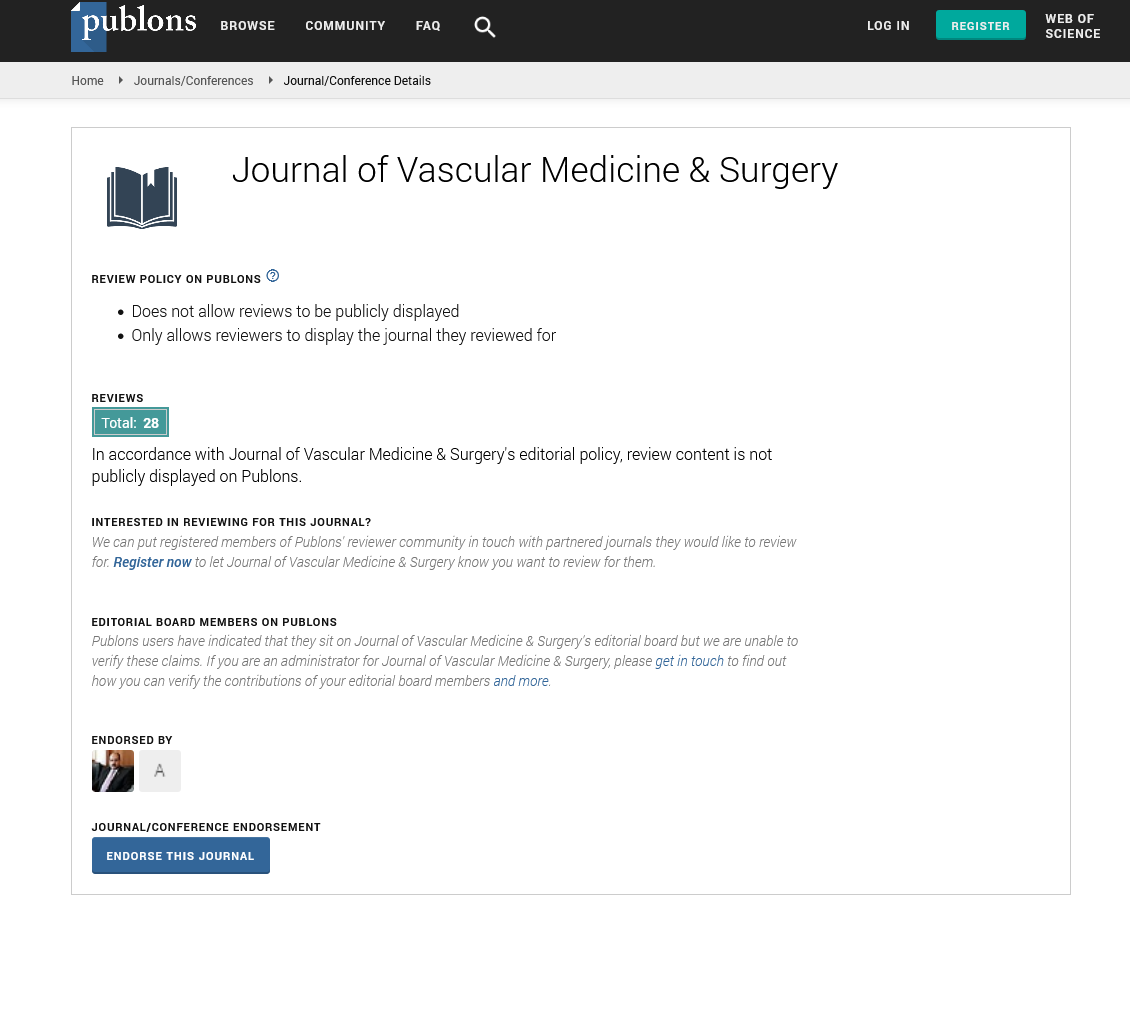Indexed In
- Open J Gate
- Academic Keys
- RefSeek
- Hamdard University
- EBSCO A-Z
- OCLC- WorldCat
- Publons
- Euro Pub
- Google Scholar
- SHERPA ROMEO
Useful Links
Share This Page
Journal Flyer

Open Access Journals
- Agri and Aquaculture
- Biochemistry
- Bioinformatics & Systems Biology
- Business & Management
- Chemistry
- Clinical Sciences
- Engineering
- Food & Nutrition
- General Science
- Genetics & Molecular Biology
- Immunology & Microbiology
- Medical Sciences
- Neuroscience & Psychology
- Nursing & Health Care
- Pharmaceutical Sciences
Commentary Article - (2024) Volume 0, Issue 0
Vascular Diseases: Risk Factors and their Impact on Circulatory Health
Tuomas Putaala*Received: 25-Nov-2024, Manuscript No. JVMS-24-27721; Editor assigned: 27-Nov-2024, Pre QC No. JVMS-24-27721 (PQ); Reviewed: 11-Dec-2024, QC No. JVMS-24-27721; Revised: 18-Dec-2024, Manuscript No. JVMS-24-27721 (R); Published: 27-Dec-2024, DOI: 10.35248/2329-6925.24.S25.563
Description
Vascular diseases encompass a wide range of conditions that affect the blood vessels, arteries, veins and capillaries responsible for transporting blood throughout the body. These conditions can lead to severe health complications, including heart attacks, strokes and limb ischemia. Vascular diseases refer to disorders of the circulatory system that can impede blood flow, causing damage to essential organs and tissues.
Types of blood vessels
When these vessels become narrowed, blocked or weakened, blood flow is affected, leading to various vascular conditions. The vascular system includes three types of blood vessels.
Hypertension (high blood pressure): Continuous high pressure damages blood vessel walls, the result leaves individuals susceptible to damage and disease.
Arteries: Arteries carry oxygenated blood from the heart to the rest of the body.
Veins: Veins transmit blood including low oxygen levels to the heart.
Capillaries: Facilitate the exchange of oxygen, nutrients and waste products between blood and tissues.
Common causes of vascular diseases
Multiple factors influence the development of vascular disorders, including.
Atherosclerosis: The buildup of fatty deposits (plaques) in the arterial walls narrows blood vessels, restricting blood flow.
Smoking: Tobacco use accelerates the damage to blood vessels and promotes plaque formation.
Diabetes: High blood sugar levels damage blood vessels and increase the risk of vascular complications.
Obesity and sedentary lifestyle: Excess weight and inactivity contribute to high cholesterol levels, hypertension and poor circulation.
Genetics: Family history of vascular diseases can increase susceptibility.
Aging: Blood vessels lose elasticity with age, increasing the risk of damage and blockage.
Types of vascular diseases
Vascular diseases can be categorized based on the affected blood vessels and the nature of the condition. Major types include: Peripheral Arterial Disease (PAD) occurs when atherosclerosis narrows arteries, reducing blood flow to the limbs, typically the legs. Pain or cramping during walking (intermittent claudication) and slow-healing wounds. Coronary Artery Disease (CAD) is blockage or narrowing of the coronary arteries, which provide blood to the heart. Angina (chest pain), difficulty of breath and fatigue. Stroke and Transient Ischemic Attack (TIA) occur when blood flow to the brain is affected frequently due to a blood clot or damaged vessel. TIAs are temporary challenges that result in no long-term damage. Sudden weakness, speech difficulties and vision loss.
Aneurysms are expands in weakened arterial walls, which can bleeding, causing life-threatening bleeding. Aorta (abdominal or thoracic), brain and peripheral arteries. Blood clots form in deep veins, typically in the legs, resulting in pain and swelling. Increased twisted veins on the skin's surface, typically in the legs, causing inflammation. Spasms in small blood vessels reduce blood flow to extremities, causing fingers and toes to turn white or blue in response to cold or stress. Veins in the legs fail to return blood effectively to the heart, causing swelling, skin changes and ulcers.
Symptoms of vascular diseases
Symptoms vary widely depending on the type and severity of the vascular disease. Common signs include: Pain or cramping in the legs, especially during activity, numbness or weakness in the extremities, coldness in hands or feet, skin discoloration or ulcers, chest pain or discomfort, sudden vision changes or difficulty speaking (stroke symptoms) and swelling, redness or warmth in a limb (Deep Vein Thrombosis symptoms).
Diagnosis of vascular diseases
Diagnosing vascular diseases involves a combination of medical history, physical examination and diagnostic tests. Common methods include: Measure cholesterol levels, blood sugar and inflammatory markers. Non-invasive technique to evaluate blood flow and identify blockages or embolism. Detailed images of blood arteries are used to detect difficulties. Compares blood pressure in the ankle and arm to detect PAD. Monitors heart rhythm to detect coronary artery disease.
Citation: Putaala T (2024). Vascular Diseases: Risk Factors and Their Impact on Circulatory Health. J Vasc Surg. S25:563.
Copyright: © 2024 Putaala T. This is an open access article distributed under the terms of the Creative Commons Attribution License, which permits unrestricted use, distribution and reproduction in any medium, provided the original author and source are credited

